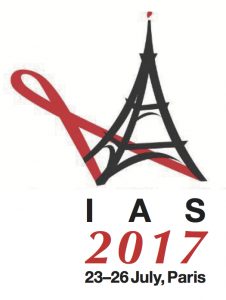MK-8591: further compelling early results for both treatment and prevention
10 August 2017. Related: Conference reports, Antiretrovirals, HIV prevention and transmission, IAS 9th Paris 2017.
 Simon Collins, HIV i-Base
Simon Collins, HIV i-Base
Two very interesting early studies were presented at IAS 2017 for the investigational NRTI MK-8591 (EFdA).
This compound in early stages of development is notable for a very high potency, a long-half life and the potential for use both as HIV treatment and for HIV prevention. Oral dosing might be weekly and PrEP includes the potential for a small removable slow-release implant that would last a year.
The first study, presented as a poster, looked at the impact on viral load of a single dose of MK-8591 (30 mg, 10 mg, 2 mg, 1 mg or 0.5 mg) in 30 treatment-naive participants (n=6 for each arm), with the recommendation to start ART after 7-10 days depending on the dose. [1]
Mean viral load reductions at day 7 were dose-related and ranged from approximately –1.2 logs (for the 0.5 mg, 1.0 mg and 2.0 mg groups) to approximately –1.6 logs (for the 10 mg and 30 mg group).
The study also looked at the pharmacokinetics of different doses, especially drug levels in plasma and PBMCs and the impact on plasma and intracellular half-life for potential dosing schedules.
Both plasma and intracellular drug levels were dose-related, with higher doses achieving levels approximately 1 log higher with the half-life in PBMCs ranging from 78 to 128 hours, allowing for a wide range of potential dosing schedules.
For reasons that are unclear, and against the study protocol, one participant did not begin full ART (risking drug resistance by continued monotherapy) although neither viral load nor resistance data were presented for the case.
The second study looking at potential for PrEP, presented as a late-breaker oral abstract, reported weekly oral doses of MK-8591 or placebo for three months in 16 macaques who were then exposed to rectal SIV (on day 6 of every weekly cycle) for 12 weeks. [2]
The results were pretty remarkable: all animals receiving the placebo became infected within 1 to 4 challenges compared to none of the MK-8591 animals, even after 12 challenges and continued follow-up for a further three months. MK-8591 resulted in a 41.5-fold lower risk of infection (95% CI: 7.3 to 237.9) compared to placebo (p< 0.0001).
Mean intracellular trough concentrations of MK-8591-TP at the time of challenge were 4.07 mM (range: 2.26-5.17) and were similar to levels achieved using a once-weekly 10 mg oral dose of 10mg in HIV positive human studies.
Taken together, these studies show that this is a compound to follow closely through the next stages of development.
References:
- Matthews RP. Single doses as low as 0.5 mg of the novel NRTTI MK-8591 suppress HIV for at least seven days. IAS 2017, Paris. Late breaker poster abstract TUPDB020.
http://programme.ias2017.org/Abstract/Abstract/5525 (abstract and poster)
- Markowitz M et al. Weekly oral MK-8591 protects male rhesus macaques against repeated low dose intrarectal challenge with SHIVC109P3. IAS 2017, Paris. Late breaker oral abstract MOAX0203LB.
http://programme.ias2017.org/Abstract/Abstract/5533

